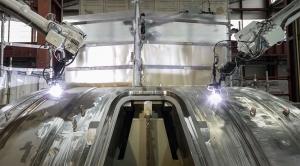The European Domestic Agency Fusion for Energy (F4E) has entrusted the AMW consortium (Ansaldo Nucleare, Mangiarotti, Walter Tosto) and its contractors with the production of five ITER vacuum vessel sectors. ENSA—already
under contract with the ITER Organization for the in-pit welding of the vacuum vessel—is one of the AMW subcontractors that is participating in this major industrial undertaking. ENSA is preparing five of the segments that will later be incorporated into D-shaped sectors in workshops in Italy. Two have already left the ENSA factory; one other departure is imminent. (Each sector is formed from
four segments.)
Seventeen people are involved with the project at ENSA. After initial manual welding, three robots are employed from different directions to complete each task. The robots are operated by a trained welder under the supervision of ENSA engineers.
In designing the equipment, the ENSA team was faced with challenges related to complex geometry, huge-sized components, and difficult 3D welding trajectories.
You can watch the result of their ingenuity in this video.
See the original article on the Fusion for Energy website.


